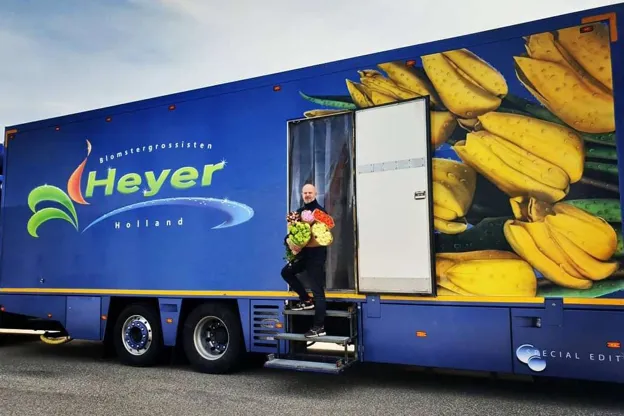“It’s a fantastic job, and it remains fun, but you can no longer retire after 20 years of driving. It’s even uncertain whether this job in its current form will still exist a few decades from now, as our kind of flower exporters is disappearing,” says Martijn van den Eijkel of Heijer Blomstergrossisten.
This Dutch has been supplying florists in Finland and Sweden with the finest flowers and plants for years. Martijn tells us more about the market and the changes he is observing.
It is fair to compare these countries, Martijn states. The biggest difference is the currency. In Finland they use the euro and in Sweden the krona.The Swedish krona has not been doing well in recent years. This makes things challenging for us and our customers.

Changes
Another difference is that customers used to be much more focused on seasons. “This focus has somewhat faded, partly because products are year-round available, or at least longer than a season. The range has become broader in this respect, and it’s no longer feasible to deliver only once a week. That used to be the norm; now it’s twice, and in the future, it might even be three times. This also impacts logistics, we used to drive as much as possible with combos, we are now increasingly driving smaller vehicles.”
The biggest change, however, is digitalization. An increasingly larger portion of purchases is made online. “In the past, we sold everything from the truck, and we brought some products that were ordered by fax. Those faxes were quite some work. Now, a large part comes in through the webshop, today the main challenge is to get everything together in time. If your logistics are well-organized, it can work out well; whether you pay a bit more or less at the auction becomes insignificant.”
Heading northwards
Martin and his business partner founded Heijer Blomstergrossisten in March 1995. To avoid competition and not to offend previous employers, “We headed northwards, and ended up in Finland.” The men started with one vehicle, made purchases on Monday morning, drove on Tuesday and Wednesday, and returned on Thursday. However, this was short-lived. They quickly started to fly more, and they added drivers and vehicles. In 2008, they acquired a Swedish transporter, followed by a Finnish company. Today, several vehicles are driving in both countries. Nowadays, on Fridays three vehicles will usually leave the Netherlands for Copenhagen, Uppsala, and Helsinki. From there, the goods are transferred to smaller vehicles that distribute them throughout the country. On Monday, 1 or 2 more vehicles will follow, depending on the volume requested.
The future
Will this kind of exporter still exist in 20 or 30 years? Martijn states that several of his colleagues have recently decided that the risk of carrying products at their own expense has become too great. “The share of loose sales is getting smaller, that’s true, most of the time extra money is required. On the other hand, it’s still a way to be distinctive and the possibility to supplement ad-hoc is appreciated. This makes you stand out from random webshops. At the same time, things continue to change, and loose sales are decreasing. As long as there is a demand for flowers, we will keep driving. We appreciate the certainty that we have nowadays, however it’s a pity that we are increasingly acting as an upscale delivery service.”
For more information: Heijer Blomstergrossisten
Heijer Blomstergrossisten
Laan van Verhof 59
2231 DZ, Rijnsburg, the Netherlands
Tel.: +31 71 303 00 16
Tel.: [email protected]
www.heyer.se/nl